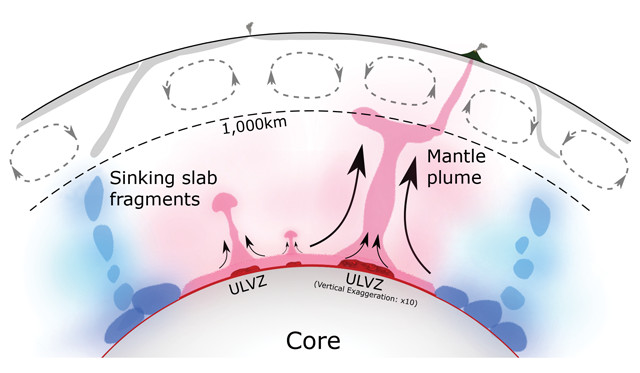
by Mary Caperton Morton Thursday, November 9, 2017

Ultralow-velocity zones (ULVZ) are patches of molten rock at the core-mantle boundary in which passing seismic waves slow significantly. Such patches may fuel plumes of hot rock that rise through the mantle to feed some volcanic hot spots, such as those beneath Hawaii and Iceland. Credit: Kaiqing Yuan and Barbara Romanowicz; modified by K. Cantner, AGI.
Home to more than 30 active volcanoes, Iceland is one of the most vigorous volcanic settings on Earth. A new look at the core-mantle boundary thousands of kilometers below the island is offering one of the most complete pictures yet of how Iceland’s volcanoes are fueled.
The boundary between Earth’s rocky, silicate-rich mantle and its liquid outer core, composed mainly of iron and nickel, lies about 2,890 kilometers beneath the planet’s surface. When seismic waves emitted by earthquakes hit this or other subsurface boundaries separating materials of different textures and densities, the waves can be slowed, stopped or refracted. Scientists can use the paths and speeds of these seismic waves to study the detailed structure of the deep interior of the planet.
Some patches along the core-mantle boundary are classified as ultralow-velocity zones (ULVZ), where molten rock slows passing seismic waves significantly. Such patches are thought to underlie and fuel plumes of hot rock that rise through the mantle to feed some volcanic hot spots, such as those beneath Hawaii and Iceland. But clearly imaging these deeply buried ULVZs is tricky because they are so far away from instruments on Earth’s surface. In a new study, co-authors Kaiqing Yuan and Barbara Romanowicz of the University of California, Berkeley, used seismic waves to create a picture of the ULVZ under Iceland. They reported in Science that it is approximately 800 kilometers in diameter and 15 kilometers thick — much larger than predicted.
“The shape of Iceland’s ultralow-velocity zone gives us some clues about its origins,” Romanowicz says. ULVZs are thought to form either as a result of partial melting of silicate mantle material or from iron enrichment of mantle rock. The symmetrical shape of the ULVZ under Iceland points to the partial melting theory, she says. Its “location, shape and large diameter, which is commensurate with the width of the plume higher up in the lower mantle, suggest a close link between the ULVZ and the rising plume above it,” the team wrote.
Earlier work has produced images of the mantle plume under Iceland, and when combined with the new ULVZ images, they help paint the clearest picture yet of the roots of Iceland’s volcanism, says Edward Garnero, a seismologist at Arizona State University who was not involved in the new research. “Previous studies have suggested a strong correlation between ULVZs and plumes and hot spots, but they haven’t proved anything yet,” he says. “This study really steps it up a notch by tying [ULVZs, plumes and surface volcanism] all together.”
Iceland’s ULVZ may not be representative of all ULVZs — dozens of which are thought to exist around the globe along the core-mantle boundary — but it may belong to a class of large-sized ULVZs that underlie volcanic hot spots fed by mantle plumes, Garnero says.
Romanowicz says she next plans to refine the team’s imagery of Iceland’s ULVZ, hoping to better define its shape, including whether it is flat-topped or peaked. She would also like to image other ULVZs, but “we are challenged by the quality of data we can get in other places,” she says. “Many of these hot spots are found in the Pacific, but we will need more broadband seismic arrays on the ocean floor to be able to study them.”
© 2008-2021. All rights reserved. Any copying, redistribution or retransmission of any of the contents of this service without the expressed written permission of the American Geosciences Institute is expressly prohibited. Click here for all copyright requests.